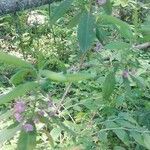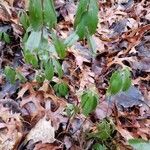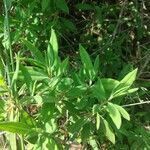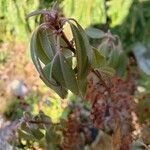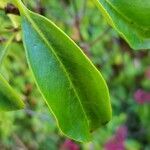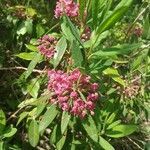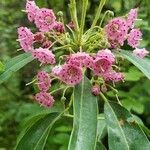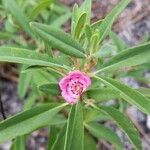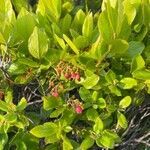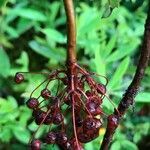Shrubs erect, 0.3-1.5 m. Twigs terete, viscid, glabrous or puberulent. Leaves usually in whorls of 3, rarely alternate or opposite; petiole 6-16 mm, usually puberulent; blade oblong to elliptic-lanceolate, 1.5-8 × 0.5-2.5 cm, margins usually plane, apex obtuse to acute, usually apiculate, abaxial surface glabrous or puberulent, sometimes stipitate-glandular, adaxial lightly puberulent (hairs white, to 0.1 mm), sometimes glabrescent, midrib puberulent. Inflorescences axillary near distal end, corymbiform racemes, 4-12-flowered. Pedicels 5-20 mm. Flowers: sepals usually green, sometimes reddish apically or throughout, ovate, 2-2.8 mm, apex usually acuminate, surfaces puberulent; petals connate nearly their entire lengths, usually reddish purple to pink, rarely white or bluish pink, usually deeper colored near anther pockets and with ring of red to purple spots just proximal to pockets, 7.5-9.5 × 6-13 mm, abaxial surface puberulent, adaxial glabrous, puberulent toward base; filaments 2.5-3.5 mm; style 3.5-4.5 mm. Capsules 5-locular, 2-3.5 × 3-5 mm, puberulent, stipitate-glandular. Seeds winged, obovoid, 0.6-1 mm. 2n = 24.
More
Branching shrub to 1 m; lvs firm, most of them ternate or opposite, short-petioled, elliptic or oblong, 3–5 cm, a fourth or half as wide, dull or somewhat bluish-green, glabrous or obscurely hairy above, paler and glabrous or with scattered stipitate glands beneath; fls several or many in short-peduncled, umbelliform or corymbiform racemes from the axils of last year’s lvs, on pedicels to 2 cm, these and the bracteoles and cal stipitate-glandular as well as finely puberulent; cor 6–12 mm wide, reddish-purple to deep pink; fr depressed-globose, 3–5 mm thick; 2n=24. Mostly in acid soils; Nf. and Lab. to Va., and inland to Mich. and s. Ont. May–July.The var. angustifolia, as principally described above, gives way at the s. to var. carolina (Small) Fernald, Carolina sheep-laurel, occurring at the margins of bogs and swamps on the coastal plain from se. Va. to S.C. and in the mts. from sw. Va. to Tenn. and n. Ga. Var. carolina is sometimes taller, to 1.5 m; lvs softly and permanently velvety-canescent beneath and with scattered stipitate glands; cal and bracteoles finely velvety-canescent, not glandular. Apr., May. (K. c.)
Can be grown by cuttings or seedlings. Seeds needs stratification.
